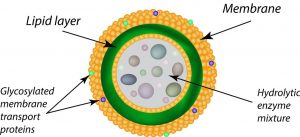Lysosomes and its functions
Lysosomes are membrane bound organelles found in animals. Lysosomes are storage organelles for hydrolases remain an inactive form. Activation takes place when the lysosome fuses with a specific organelle to form a hybrid structure.
De Duve in 1955 reported them for the first time. Lysosomes are a combined product of the endoplasmic reticulum and the Golgi apparatus and contain a large number of hydrolytic enzymes.

Kinds of Lysosomes (Polymorphism Of Lysosomes)
De Robertis et al. (1971) gave the concept of polymorphism of lysosomes. According to him, This polymorphism is due to the association of primary lysosomes with the different materials that are engulfed by the cells.
They are of four types:
(i) Primary
(ii) Secondary
(iii) Residual bodies
(iv) Autophagosomes or cytolysosomes
(1) Primary Lysosomes : (Storage granules)
They are also known as storage granules as they are small sac like filled with enzymatic contents that are synthesized by ribosome and accumulated in ER. From there they enter the Golgi in GERL region which is known to be involved in the production of lysosomes. These lysosomes comprise only one type of enzyme or another.
(2) Secondary lysosomes : (Digestive Vacuole or Heterophagosome)
The phagosomes or pinosomes when fuse with primary lysosomes, they are known as secondary lysosomes. These lysosomes have engulfed material and hydrolytic enzyme within its membrane. These lysosomes digest the engulfed material and passes through the lysosomal membrane into the cytoplasm for metabolic uses.
(3) Residual bodies :
Due to lack of certain enzymes in the lysosomes,its own digestion is incomplete thus they form residual bodies. These bodies are eliminated by the organism and sometimes, they are retained in the body causing ageing. These residual bodies may cause fever, hepatitis, hypertension etc in human beings or may form myelin figures, due to accumulation of debris which are mostly lipid in nature.
(4) Autophagic vacuole (Cytolysosome or autophagosomes)
Sometimes, intracellular parts such as mitochondria or endoplasmic reticulum may be digested by the lysosomes. Such lysosomes are known as cytolysomes or autolysosomes or autophagic vacuoles, Under physiologic or pathologic conditions, these autophagic vacuoles may cause digestion without irreparable damage. During starvation,liver cells. shows numerous autophagosomes.
Functions:
▶Intracellular Digestion :
The endocytosed macromolecules formed by the process of phagocytosis or pinocytosis are digested by the lysosomes. Phagosomes or pinosomes fuses with the lysosomes to bring about the digesion. Sometimes, the cell organelle of the same cell fuses with the cells own lysosome to form autophagosames which are then by the action of certain proteolytic enzyme, (Catepsins) are digested. To get rid of cell debris of the dead cells, the cells have mechanism of autodigestion. During autodigestion, when a cell dies, the lysosome membrane ruptures and the enzyme are liberated, which then digest the dead cell.
▶Extracellular Digestion:
- Role In The Process Of Fertilization :
During the penetration of sperm into the ovum, the lysosomal enzymes play the important role. Acrosome contains protease hyaluronidase and acid phosphates which digests the zona pellucida making a passage through which sperm nucleus penetrates.
- Role In Osteogenesis:
The lysosomal enzymes degrade the osteoclast of the bone to the organic matrix. The ageing of cells and parthenogenetic development are also due to the lysosome’s activity.
- Lysosome Function Disorders:
There are about 30 fairly rare disorder in humans that are due to defects in lysomal function. These disorders are due to lysosomal storage problems or errors in the genetic codes. Genetically driven disorders of the lysosomes can cause impaired platelet synthesis and hypopigmentation.
